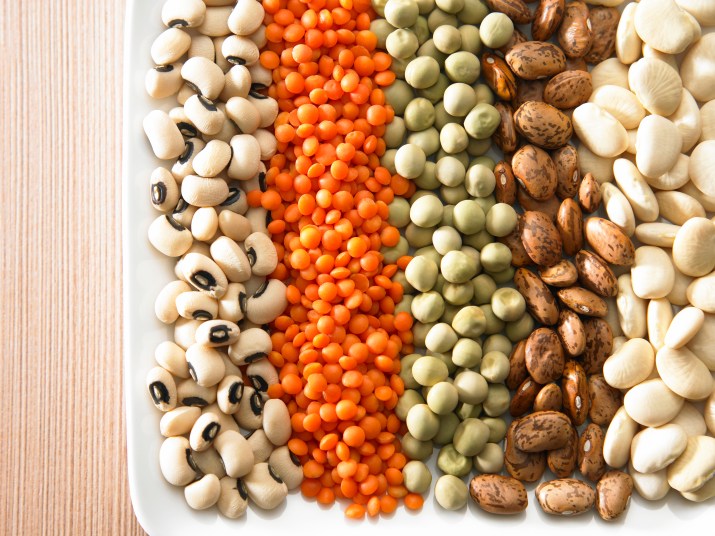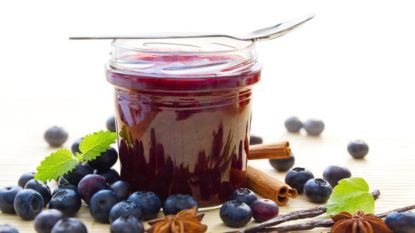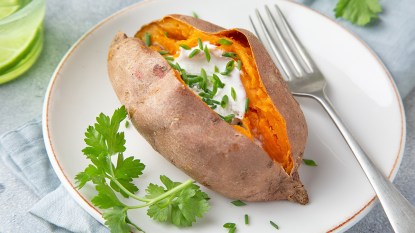The 5 Most Underrated Healthy Foods in Your Kitchen

While quinoa, kale, and blueberry smoothie bowls have taken centerstage on social media, there are many humble foods in our kitchen that deserve a chance in the spotlight. All nutritious foods contribute towards good health, but it’s time to drag the most underrated foods in your kitchen out of the shadow of chia pudding. Keep scrolling for five healthy foods you should use more.
1. Pulses
With an array of beans and peas in this group there is a legume for every occasion. Pulses are the original gluten-free option, and now a variety of pulses can be bought as flours for those who wish to experiment with gluten-free baking. They also provide both soluble and insoluble fiber, which make way for healthy gut bacteria and good bowel function — and you need a happy digestive system for a happy life.
Adding chickpeas, lentils, broad beans, lupins, or field peas, to your life will give you many benefits, according to dietitian Georgie Rist.
“Pulses are gluten free, low in fat, and contain plant sterols, which can be beneficial in lowering cholesterol. Packed with antioxidants, vitamins, and minerals, they are an important and cheap addition to every diet,” she says. Whether they are the main event in a meal or an addition to bulk up your salad, the protein, iron, calcium, and folate hit from legumes make them an underrated pantry star.
2. Kiwis
This furry little unsuspecting fruit needs to hold his green head high and be counted in the “superfood” category. This nutritious fruit has health benefits for almost every part of your body, from your eyes to your gut to your immune system.
“Kiwi fruit has almost double the vitamin C content of an orange,” says Rist. “One large golden kiwi fruit provides more vitamin C than one glass of açai juice, and at a fraction of the cost. Including kiwi fruit with your meal can help to increase the absorption of iron from plant foods.”
Kiwis are also packed with magnesium that supports muscle function, potassium, folate, zinc, and antioxidants just to name a few.
3. Nuts
Our bodies go nuts for nut whether they’re activated, roasted, or raw. “Nuts not only taste delicious, but.. the science [backs] them up when it comes to including a handful a day [to help] support healthy weight management, [lower] diabetes risk, lower cholesterol, and improve heart health,” says Georgie.
One study found that one ounce of nuts per day has more health benefits than eating a low-fat diet. Opt for a a small handful of nuts, otherwise nuts’ high fat content may cause weight gain.
Each nut contains a unique variety of nutrients, with almonds, walnuts, macadamias, hazelnuts, and cashews being among the most popular. A dollop of good-quality nut butter makes a delicious addition to your smoothie, and, believe it or not, your stir-fries!
3. Watermelon
Nothing sings summer like a cool slice of juicy watermelon. And this water packed fruit is not just delicious — it’s also a powerful antioxidant. Watermelon contains lycopene, which is a powerful carotenoid oxidant that’s most commonly attributed to another red fruit — tomatoes.
Although tomatoes are another underrated food, watermelon has a more concentrated level of the cancer-fighting, stroke-busting carotenoid. Some research suggests it may help to significantly reduce blood pressure and improve heart health, which is a bonus because it is also good for sexual function. Watermelon is sometimes referred to as “nature’s viagra” due to the levels of L-arginine present.
4. Spinach
Kale chips, kale smoothies, braised kale, kale, kale, kale. You would think kale is king after hearing so much about it, however many people don’t realize that spinach still reigns supreme.
“Kale has been receiving a lot of attention of late, but what many people don’t know is that spinach is actually higher in a number of nutrients than kale, including iron, magnesium, potassium, and vitamin E,” says Rist. “I side with Popeye on spinach, and don’t go a day without my cup of spinach!”
One cup of cooked spinach provides 180 mg of calcium (15 to 20 percent of recommended daily allowance), and 1/2 cup cooked spinach provides 80 mg magnesium and 100 mcg folate, over 20 percent of recommended daily intake (RDI) for both.
Dark green vegetables are high in fiber and are great for your immune system. Eat a variety of leafy greens to keep life interesting.
5. Avocado
This rough skinned fruit may hold the secret to your youthful skin as it naturally wants to fight free radical damage and keep you young.
Just 1/2 an avocado provides a handful of antioxidants, plus 22 mg of vitamin C, 120 mg of folate (30 percent of the RDI), and 4.3 grams of fiber (14 percent of the RDI).
“The healthiest foods to choose are those that pack a nutritional punch. That is, they should be nutrient-rich, compared with their energy (calorie) content, and provide food components such as fiber, antioxidants, healthy fats, vitamins, and minerals. And they should also contain only minimal amounts (if any) of saturated fat, added sugars, and salt,” says Rist.
“There is no one size fits all when it comes to diet. We are all different and respond to food differently. Vegetables are wonder foods! However, for optimal health we need to focus on a ‘super diet’ packed with a variety of nutritious foods, rather than just than one or two superfoods!”
This article originally appeared on our sister site, Now to Love.
More From FIRST
5 Alternatives to Chips That Still Feel Snacky
How to Ripen Bananas Quickly When You Need to Make Banana Bread ASAP
Sweet Potato ‘Toast’ Is a Gluten-Free Bread Alternative Even Tastier Than It Looks













